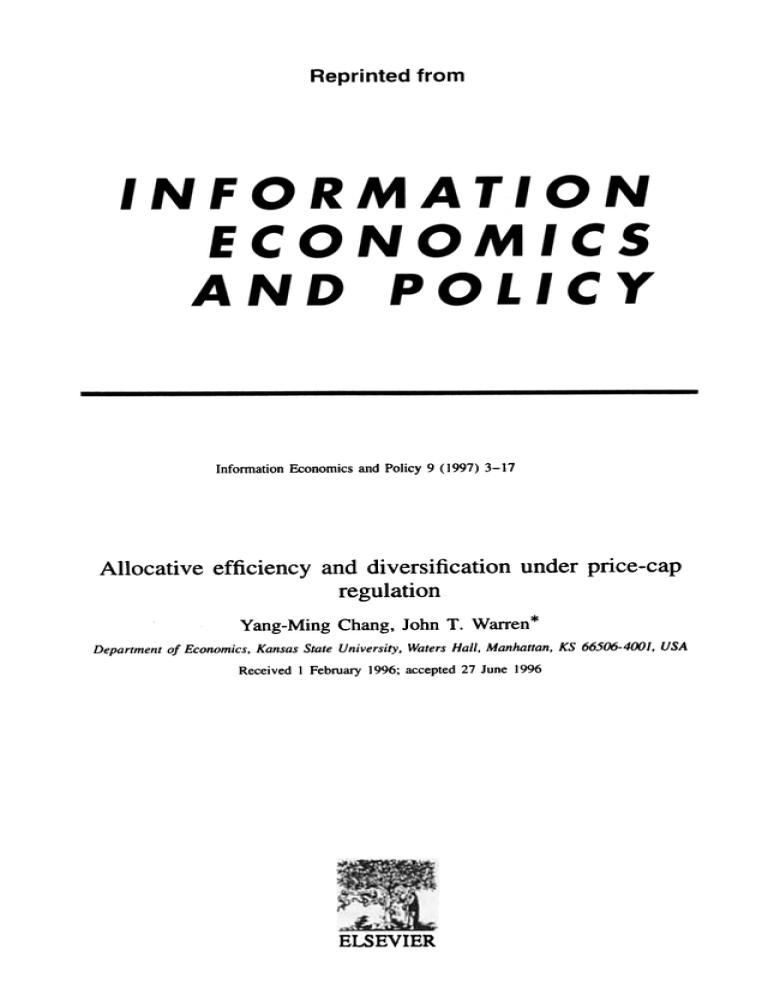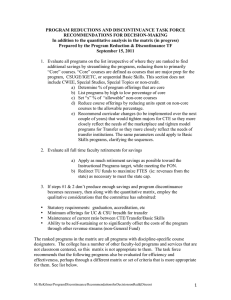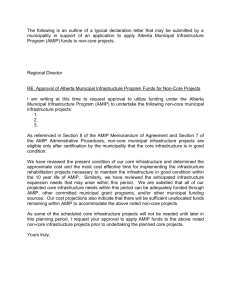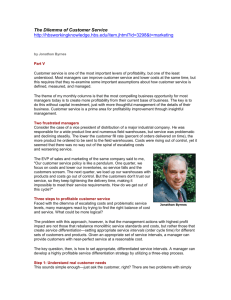Allocative efficiency and diversification under price-cap regulation
advertisement

Reprinted
from
Information Economicsand Policy 9 (1997) 3-17
Allocative efficiency and diversification under price-cap
regulation
Yang-Ming Chang,John T. Warren*
Department of Economics.KansasState University, WatersHall. Manhattan,KS 66506-4001,USA
Received I February 1996; accepted 27 June 1996
ELSEVIER
INFORMATION
ECONOMICS
AND
POLICY
ELSEVIER
Information Economicsand Policy 9 (1997) 3-17
Allocative efficiency and diversification under price-cap
regulation
Yang-Ming Chang,John T. Warren*
Department of Economics,KansasState University,WatersHall, Manhattan,KS 66506-4001,USA
Received1 February1996; accepted27 June 1996
Abstract
This paper shows that the effect of price-cap (PC) regulation and modified price-cap
(MPC) regulation on the allocative efficiency and diversification of core and non-core
goods depends crucially on (i) whether core and non-core goods are complements,
substitutes,or independent,and (ii) whetherthe non-coremarketis perfectly or imperfectly
competitive.UnderPC regulation,efficient productionof the core good is impossibleunless
the non-coremarketis perfectlycompetitive. Further,we showthat the regulatedfirm may
or may not supplyless output in the non-coremarketunder MPC than underPC regulation,
dependingupon, in part, whetherthe schemeof commoncost allocationis basedon eithera
monotonic method or a relative revenuemethod. Also, a perfectly competitive non-core
marketimplies core-marketoverproductiondistortion underMPC. We discussimplications
for the entry of the 'Baby Bells' into long-distanceand cellular markets.
Key words: Price-capregulation; Productionefficiency; Diversification
JEL Classification: LOO;L51; L96
1. Introduction
The question of whether price-cap (PC) regulation is superior to cost-based
(CB) regulationhas attractedconsiderableattention!For example,Braeutigamand
* Correspondingauthor. Tel: (913) 532-4573;fax: (913) 532-6919.
I See,for example,Braeutigamand Panzar(1989, 1993),Brennan(1989), and FederalCommunications Commission(1988), 1992). As pointed out by Braeutigamand Panzar (1989), CB regulation
combineselementsof rate-of-returnregulation with fully distributedcost pricing under which firms are
subject to zero profit constraint in the regulatedcore market. PC regulation establishesa price cap
constraintin the regulatedcore market where a firm can retain all of the profits it generatesin the core
market, and allows the firms to enter into non-coremarketswithout any constraints.
0167-6245/97/$15.00
PII
@ 1997 Elsevier Science BY. All rights reserved
SOI67-6245(96)00017-0
Y. Chang,J.T. WarrenI Information Economicsand Policy 9 (1997)3-17
4
Panzar (1993) point out that the federal government and more than 30 state
regulatory agencies in the telephone industry have adopted policies that involve
some form of 'incentive regulation', i.e., regulatory schemes that contain, to some
degree, PC rather than the traditional, strict CB features.2 Braeutigam and Panzar
(1989) develop a theoretical model to show that PC regulation can induce the
regulated firm to achieve allocative efficiency in both core and non-core markets.
In their analysis, Braeutigam and Panzar discuss the case where core and non-core
goods are independent.
Recently, however, Weisman (1993) presents an example which shows that if
one relaxes certain assumptions about PC regulation, then PC may not be superior
to CB regulation. Specifically, Weisman discusses the so called modified price-cap
(MPC) regulation under which firms are required to allocate costs common to both
core and non-core goods and are allowed to retain a specified portion of profits
earned in the core market. He also points out that MPC regulation combines
elements of CB and PC regulation and that MPC regulation is pervasive in the
telecommunications industry today. Weisman characterizes the non-core market as
one in which prices are set competitively (the firm is a price taker), and he shows
that there is an underproduction distortion in the non-core market. In his analysis,
Weisman assumes that the core market is independent of the non-core market.
Several important questions remain unanswered. What is the effect of PC or
MPC regulation on the allocative efficiency and diversification of core and
non-core goods when these two goods are complements or substitutes and when
the non-core market is characterized by imperfect competition? Is production of
the core good efficient? If not, then what would be the amount of profit tax on the
good in the core market that would lead the regulated firm under MPC regulation
to efficiently supply the core good? Would the answers be affected by alternative
schemes for common cost allocation? What would be the effect of the form of
common cost allocation on the efficiency of the non-core good under MPC
regulation? Further, what would be the effects of considering the non-core market
in an oligopolistic framework, specifically as a duopoly in which firms either
employ Cournot strategies or behave in a quasi-perfectly competitive fashion as
special cases? The purpose of this paper is to present answers to these questions.
It should also be mentioned at the outset that, whereas Braeutigam and Panzar
(1989) and Weisman (1993) consider the case in which the core market is
independent of the non-core market, we develop a more general framework in
which the core and non-core markets may be related to each other under the
assumption of a duopolistic non-core market with special cases of Cournot
competition and quasi-perfect competition.3 These considerations are timely in
view of recent news reports in the business press. Kupfer (1994) reports strenuous
2 More recently, Sappington and Weisman (1996) have systematically examined alternative forms of
incentive regulation that are employed in the telecommunications industry.
3 It can be shown that our results can be generalized to the case of n non-regulated firms in the
oligopolistic
non-core market.
Y. Chang,J.T. Warren tlnformation Economicsand Policy 9 (1997)3-17
5
efforts by the 'Baby Bells' to enterthe long-distancemarketprior to the legislation
which enablesthem to do so (p. 95). Following this legislation,local service(core
market) would be a complementto long-distance service (non-core market).
Long-distanceservice (non-core market) would be either oligopolistic, as in the
caseof intercity calls, or monopolistic,as in the caseof calls betweena major city
and its surroundingsuburbswhen the same firm servesboth.4
Another relevant observationis that cellular phone serviceis an example of a
non-core market which is a substitute for core-market local service, and this
market is, in general,01igopolistic.5Thus we see that the incentive for the Baby
Bells to expand into the substitutecellular market is great and merits pareful
analysis.
In this paper,we will show that the effect of a pure price-capregulationand a
modified price-cap regulation on the efficiency and diversification of core and
non-core goods depends on whether these two goods are complements or
substitutesand whetheror not the marketfor the non-coregood is characterizedby
perfect competition. If the core good and non-core goods are complementsor
substitutesand if the non-core market is imperfectly competitive,the firm under
PC regulationwill neverproducethe good efficiently in the regulatedcore market.
In other words,efficiency in the core good can not be achievedunlessthe core and
the non-core markets are assumedto be independentor the non-core market is
assumedto be perfectly competitive,as in Braeutigamand Panzar(1989). In the
caseof perfect competition in the non-core market,the regulated firm under PC
regulation will efficiently supply the non-core good, regardlessof whether core
and non-core goods are complements,substitutes,or independentunder perfect
competition. However, under the conditions of a Cournot game in the non-core
market, we will observeboth core and non-core market inefficiencies under PC
regulation.Findings in the presentpaper suggestan interestingpolicy implication
that is ignored in the literature on PC regulation. That is, under PC regulation,
diversification in the non-core market is achievedat the expenseof efficiency in
the core market when demandsfor core and non-coregoods are not independent
and when the non-core marketis characterizedby imperfect competition.
We also attemptto investigate'efficient' taxationunderMPC regulation,6where
the regulatorallows the firm in the core market to retain only a shareof profits
4 "Such calls [betweencities and their suburbs]are high-marginitems: They cost about the sameas
a local call, yet regulatorsallow the Baby Bells to chargeabout five timesas much" (Kupfer, 1994,p.
95).
5 "Baby Bell executivesgo weak when they think what could happenif cellular phonesbecomea hit
in the massmarkeL.. in New York City, cellular revenuesrose 40% in the past year, while the Baby
Bell revenuesgrew only slightly. The operatingprofit on cellular calls is nearly 25%, vs. 20% for the
businessas a whole" (Kupfer, 1994,p. 102). Further,Weismanhas communicatedto us that SBC
CommunicationsInc. has expandedheavily to the cellular market.
6 Although Weisman(1993) considersbotha constanttax and a tax that risesas a function of profit
in the core market, we will consideronly the former casesince, otherwise,problemsof endogeneity
arise.
(1
6
Y. Chang,J.T. Warren Ilnfonnation Economicsand Policy 9 (1997)3-17
earnedby the firm. We will performthis investigationundertwo different methods
for the allocationof costscommonto productionof core and non-coregoods.They
are basedon fixed cost allocation by (1) a monotonicmethod?and (2) a relative
revenuemethod. It will be shown that the regulated firm under MPC regulation
will supply inefficiently less output in the non-core market than under PC
regulation whenevera monotonic method of common cost allocation is used
regardlessof (i) how the core and non-coregoodsare relatedto eachotherand (ii)
whetherthe non-core market is oligopolistic and representsa Cournot game or
perfect competition. However, under the relative revenue method,the regulated
firm mayor may not supply less output in the non-core market under MPC than
underPC regulation,dependingupona hostof factors which we will developlater.
Also, it will be shown that under MPC regulation, if the non-core market is
perfectlycompetitivethere will be an overproductiondistortion in the core market.
Although the analysisin the paperis centeredaroundtwo different methodsof
commoncost allocationfor MPC regulationwith a positive profit tax on the good
in the core market,the caseof PC regulationcan easilybe analyzedby letting the
profit tax equal zero. The rest of this paper is organizedas follows. Section 2
discussesthe case of common cost allocation based on a monotonic method.
Section3 considersthe caseof the relative revenuemethod.Concluding remarks
appearin Section4. Resultsare summarizedin Tables 1 and 2.
2. Common cost allocation based on a monotonic method
Consider first a monotonic method defined for Yi and Yza' which are ~he output
levels of core and non-core goods produced by the regulated firm. Let fly) be the
fraction of fixed costs that are allocated to the core good, where Y = (Yl' Yza)'
Following Sweeney (1982), we define fixed costs as allocated by a monotonic
method if for each value of y, fly) satisfies the following conditions: (i) flY»O
for aJl Y such that Yl>O and Yza>O; (ii) h =iJfliJYi >0 for all y~O; and (iii)
/za=iJfliJYza <0 for all Y such that Yza>O. Again, from Sweeney (1982), we
identify the 'relative output method' as
fly) ~ Yl/(YI + Y2a)
a,nd the 'attributable cost method' as
f(J!) ~ C1(Yl)/[C1(Yl)
+ C2a(Y2a)]'
(2)
7 Although Braeutigam(1980) discussesthe threecasesof (I) relative output, (2) attributablecost,
and (3) relative revenue,we follow Sweeney(1982) to combinethe first two casesinto one where the
shareof fixed costsattributableto core good is a monotonicallyincreasingfunction of the amount of
the core good sold and a monotonicallydecreasingfunction of the amountof non-coregood sold. A
formal definition appearsin Section2.
Y. Chang, J.T. Warren Ilnfonnation Economicsand Policy 9 (1997)3-17
7
where Ci(Yi) represents the total variable costs attributable to production of good i
(i= 1, 2a). These two methods are examples of a monotonic method since it is
easily shown that they conform to (i)-(iii) of the definition.
In order to examine the general case in which core and non-core market goods
are not independent, the market demands for the two types of goods produced by
the regulated firm are specified as follows:
PI=PI(YI'YZ)
and- PZ=PZ(YI'YZ)'
(3)
where PI is the price of core good, pz is the price of the non-core good, Yzais the
non-core output level of the regulated firm, YZbis the output level of another firm
I
producing the non-core good and Yz=Yza +YZb. The regulated firm faces a
price-cap constraint in the core market which is given as PI :5pf, where pf is a
price cap set by the regulatory commission. In this case, even though there is a
price cap, production of the core market good, Y I' can change. Following
Braeutigam and Panzar (1989) and Weisman (1993), we assume that the price cap
constraint binds, that is,
PI=pf.
(4)
The problem facing the regulated firm then is to choose y 1 and Y2a in order to
maximize its joint profit function subject to the binding price-cap constraint in Eq.
(4). The Lagrangian function is:
..'t' = (1 -t1)[P~Yl
-[1~- !(Yl'
-!(Yl'
Y2a)F -C1(Yl)]
+ P2(Yl' Y2a+ Y2b)Y2a
Y2a)]F -C2a(Y2a)'
(5)
where t 1 is profit tax on the core market good under MPC regulation and F is the
regulated firm's common (fixed) cost. We assume that the marginal cost in each
good is positive and increasing. Before examining the optimality conditions under
MPC regulation, it should be noted that the case of PC regulation can easily be
analyzed by setting t1 =0 in Eq. (5), such that there is no profit tax on the core
good and no common cost allocation problem.
The necessary conditions for profit maximization are:
iJ..'t'!iJYl= (1-
-1
T1)[pr
-iJF
-C1(Yl)]
+ [iJP2!iJYl+ (iJP2!iJY2)(iJY2b!iJYl)]Y2a
+ iJF = 0,
iJ..:t'liJY2a
= (1-
TI)(-haF)
(6)
+P2 + (iJp2IiJY2)[1 + (iJY2b/iJY2a)]Y2a
+ haF
f"
-C;:(Y2a)
= 0,
(7)
where C: =dCI IdYl and C;:=dC2a IdY2a'
Two points with respect to the above conditions should be noted. First, we will
assume that iJy2bI iJyI = O. That is, the regulated firm believes that the other firm's
production level of the non-core good (Y2b) is independent of the regulated firm's
8
Y. Chang,J.T. Warren tlnformation Economicsand Policy 9 (1997)3-17
production of the core good (y,). Also, in order to examine market conduct in the
non-core market we consider Coumot competition in which aYzb/aYZa=O, and
(quasi) perfect competition in which aYzb/aYZa=-1.
The profit function of the unregulated firm in the non-core market is given as
7Tb= pz(y"
Yza+ YZb)YZb-CZb(YZb)'
(8)
where C2b(Y2b)is the firm's cost function with positive and increasing marginal
cost. The firm is assumed to maximize its profit by producing the non-core good
up to the level Y2b at which the following condition is satisfied:
P2 + (iJP2/iJYI)(iJYI/ iJY2b)Y2b
+ (iJP2/iJY2)(1 + iJY2a
/ iJY2b)Y2b
-C;:(Y2b)
= 0
(9)
where C;~=dC2b/dY2b.For the case in which the unregulatedfirm believes that
the regulatedfirm's choice of the core good is independentof its own choiceof the
non-core good, we have iJYIliJY2b=0.
In what follows, we will discuss several casesconcerning the effect on the
production efficiency and diversification of the core and the non-core goods in
terms of the relationship betweenYI and Y2' noting that Y2=Y2a
+Y2b. We first
considerthe core market good. It follows from Eq. (6) that
(1-
T\)[pf
-c:(Y\)]
= (1-
T\)hF
-[i)P2/i)y\
+ (i)P2/i)Y2)(i)Y2b/i)Y\)]Y2a
-hF.
(10)
Assuming the regulated firm believes that the unregulated firm's choice of the
non-core good (Y2b) is independent of its own choice of the core good (y,), we
have aY2b/ay,=0. Hence, we have
-c
1
I(Yl)
= [1/(1
--p~
-T1)][ -T1hF
-(iJP2/
iJYl)Y2a]'
(11)
Case I: YI and Y2aare complements. It follows from Eq. (11) that for 0< t 1< 1,
p~~C:(YI) if -t1hF
-(iJp2IiJYI)Y2a ~O or if
(lIYl)[
-t1fF~.1
-pzYza/El.J
~ 0,
(12)
where Ef.l [=(iJjliJY1)(Y.!f)=j.(Y.!f)]
is the elasticity of the common cost
allocator of the core good with respect to its output level, and El.2 [=(iJy.1
iJP2)(P2/Yl)] is the cross elasticity of demand for the core good with respect to the
price of the non-core good. Since Yl >0, we have -t1jF~,.
~P2Y2a/El.2' noting
that Ef.l>0. Also, the assumption that Yl and Y2 are complements implies that
El.2<0. Hence, we have the following result:
Y. Chang, J.T. Warren !Information Economicsand Policy 9 (1997)3-17
pf ~(:5)C:(YI)iftl
:5(~)ti,
where
>0.
9
T-* I = -PzYza I(Ff~,1 El,Z)
13)
Three possibilities exist. (i) If t1=t~,
then p*=C:(Yl)'
which implies
efficient pricing in th~ core market. (ii) If O<t1 <t~, thenp~>C:(Yl)' which
implies that there is an underproductiondistortion in the core market underMPC
regulation. Finally, (iii) if t1>t~, thenP~<C:(Yl)' which implies that there is
an overproductiondistortion in the core market.
Case II: Yl and Yza are substitutes. When the two goods are substitutes,
apz/ aYl >0. It follows from Eq. (11) thaitPt<C:(y,)
sincethe right-handside of
Eq. (11) is always negative; hence this result holds for T, >0 or T, =0. In this
case, the aforementioned overproduction distortion in the core market is implied.
The above findings can be summarized in the following proposition:
Proposition 1. If an unregulatedfirm in the non-core market engagesin a
Cournot game with a firm which is regulated in the core market then:
(a) Under PC regulation (tl =0) with a monotonic method,the regulatedfirm
will have an incentiveto underproducethe core good (up to where pr>C:(YI) if
core and non-coregoods are complements;but thefirm J-!:illhave an incentive to
overproducethe core good (up to wherepr<C:(YI» if core and non-coregoods
are substitutes.
(b) Under MPC regulation (t I >0) with a monotonic method,if the core and
non-coreproducts are complements,efficientproduction of the core good obtains
--* equals T., where T.
-* = -P2Y2a/(Ff~.IEI.2»0, Otherwlse,forO<T1<
.whenT1
t~, there is an underproduction distortion; and for t. > t~, there is an
overproductiondistortion in the core market. If core and non-coreproducts are
substitutes,efficient production is impossiblesincepr <C:(YI) for all O<t. < 1,
and there is an overproductiondistortion in the core market.
Now we considerthe non-core market. The optimality condition in Eq. (7),
underthe assumptionof a Coumotgame in the non-coremarket(i.e., aYZb/aYza=
0), can be rearrangedto yield
-2a
TlhaF
+ P2 + (iJp2IiJY2)Y2a-C2a(Y2a) = O.
(14)
Sinceha<O, we have (iJp2IiJY2)Y2a+P2-C;:(Y2a)=
-T1haF>0.
Letting the
marginal revenue for the non-core market good be denoted as MR2a' we have
MR2a = iJ[P2(YI' Y2)Y2a]
I iJY2a
=(iJp21 iJY;)Y2a+ P2' It follows from Eq. (14) that if
the non-core market is characterized by Coumot competition, then MR2a> C;: for
all T1 >0, For the case in which the non-core market is quasi-perfectly competitive, we have iJYibliJY2a= -I;
hence, P2-C;:(Y2a)=
-T1haF>0.
This
implies that under MPC regulation (T 1>0) there is an underproduction distortion
3.
10
Y. Chang,J.T. Warren / Information Economicsand Policy 9 (1997)3-17
in the non-coremarket,regardlessof whetherthe non-coremarketis characterized
by Cournotcompetitionor perfectcompetition. If the non-coremarketis perfectly
competitive, then the regulated firm under PC regulation (t 1= 0) will have an
incentive to efficiently supply the non-core good.sThis is becausein this case
Pz= C;:(Yza).We thereforehave the following proposition:
Proposition2. In the case of a monotoniccommoncost allocation, the regulated
firm will have an incentiveto supplya smaller amount of the non-coregood under
MPC regulation than under PC regulation regardless of (i) whether core and
non-coregoodsare complements,substitutes,or independent,and (ii) whether the
non-coremarketis characterizedby Cournotcompetitionor perfect competition.If
the non-core market is perfectly competitive, the regulated firm under PC
regulationwill efficiently supplythe non-coregood regardless of whethercore and
non-coregoods are complements,substitutes,or independent.
Proposition2 implies that underMPC regulationwith a monotonicmethod the
regulated firm tends to underproducein the non-core market. As a result, MPC
regulationis inferior to PC regulationas far as the underproductiondistortion is
concerned.
Common cost allocation based on the relative revenue method
Next. considerthe relative revenuemethod defined as follows:
h = Ply./(P1YI + PZYZa).
Given the price-cap constraint where PI =pf and substituting the demand
function for the non-core good in Eq~ (3) into Eq. (15), we have
h =pfy,/[pfy,
+PZ(YI'YZ)YZa].
(15')
The rate of change of the allocator h with respect to YI is given as
hi = ahlaYI
= {pr PZ(YI' YZ)Yzal[prYI + PZ(YI' YZ)Yza]Z}(l -l/EI,z)
(EI,Z~O)
where El,2is defined as before as the cross elasticity of demand for Y1 with respect
to P2' In the relative revenue method with a price-cap constraint, the Sweeney
(1982) conditions of monotonicity may be violated, depending upon whether the
core and the non-core goods are complements or substitutes,
8 This result is consistent with that of Braeutigam and Panzar (1989).
Y. Chang,J.T. Warren / Information Economicsand Policy 9 (1997)3-17
11
For the case in which YI and Y2aare complements (E"1.2<O),we have hI >0. But
for the case in which YI and Y2 are substitutes (E"1.2>O),hI can be positive,
negative, or zero. That is, (i) hI >0 if E"1.2>1, (ii) hI <0 if 0< E"1.2
< 1, and (iii)
hl=OifE"I.2=1.
Next, we derive the rate of change of the allocator h with respect to Y2a as
follows:
h2a = cJh/cJY2a
= -{P~P2YI/[P~Yl
+P2(YI'Y2)Y2a]2}[I+Y2a/(Y2E"2)]
(E"2~O)
(17)
where E"2[=(cJY2/cJP2)(P2/Y2)] is the price elasticity of market demand for the
non-core good. Hence, h2a<0 when E"2:5Y2a/Y2'and h2a~0 when -Y2a/Y2<
E"2
< O.
The Lagrangian function for the profit-maximizing regulated firm under MPC
regulation with the relative revenue method is given as
":£~(1 -f Z)[ptYI -h(YI'
-[1 -h(YI'
Yza)]F -C
Yza)F -CI(YI)]
Za
+ PZ(YI' Yza+ YZb)YZa
,
(Yza)'
(18)
where f Z is the profit tax on the core good. The necessary conditions in this case
are similar to those in Eq. (5) and Eq. (7) except that the allocator f and its
derivatives are replaced by the allocator h and its derivatives, and f 1 is replaced
by fz.
We first consider the core market good. The optimality condition with respect to
Y1 can be rearranged as follows:
pt -C:(YI)
~ (1 -f Z)-I{ -f zhlF~ [(1-
--I
Tz)YI]
(iJPzliJYI)Yza}
-
[-TzhF~h.1 -PZYZa/~I.Z]'
(19)
where ~h.1 [=(iJhliJYI)(Yllh)~hl(Yllh)]
is the elasticity of the allocator h with
respect to the output level of the core good.
If YI and Yz are complements (~I,z<0) such that hi >0, then we have
pt 2::(~)C:(YI)
> 0,
if f z ~ ( 2::)f:,
where
f:
~ -pzYza/(hF~h,1 ~I,Z)
(20)
which imply the samequalitativeresultsas for the monotonicmethod for the core
market.
However, if y, and Y2 are substitutes(E',2>O), we will have the following
cases:
Case(1). For ~1.2>1 such that h1>O and ~h..>O,we have from Eq. (19) that
pf < C: (y I)' which implies that thereis an overproductiondistortion in the core
market.
12
Y. Chang,J.T. WarrenI Information Economicsand Policy 9 (1997)3-17
Case(2).
For O<El,2<1
such that h1<O and Eh,I<O, we have from Eq. (19)
that
pf ~ (~)C:(Yt)ifT2
~(~
)T~, where
T-* 2 -= -P2Y2a I(hfEh,1 El,2)
>0.
Thereare threepossibilities: (i) If t 2= t~, thenpf = C:(Yl)' and there is efficient
pricing in the core market. (ii) If O:5t2<t~, then pf<C:(Yl)'
and there is
overproduction distortion in the core market. Finally, (iii) if t 2> t~, thenpf>C:(Yl
and hencethere is an underproductiondistortion in the core market
under MPC regulation. The above results are summarized in the following
proposition:
Proposition 3. Assumea Coumot game betweenan unregulatedfirm in the
non-core market and a firm that is regulated in the core market. Under MPC
regulation with the relative revenuemethod,we have thefollowing results:
(a) If the core and non-coreproducts are complements,efficient production of
.--* when T 2 equals T 2' where T-*2 = -P2Y2a/(hjEh,IEI,2)
the core good obtaIns
> o.
Otherwise,for 0 < t 2< t~ and hi >0, there is an underproductiondistortion;
and for t 2> t ~ and hi < 0, there is an overproduction distortion in the core
market.
(b) If the core and non-coreproducts are substitutes,and if EI,2~ 1 such that
hi ~o, efficientproduction of the core good is impossiblesincefor all o<t 2< 1,
pf<C:(Y,) and there is an overproductiondistortion in the core market. But if
0<EI,2<1 such that h,<O, efficiency of the core good obtains when t2 equals
t ~, Otherwise,for 0< t 2< t ~, there is an overproductiondistortion; and for
t 2> t~ ' there is an underproductiondistortion in the core market,
Next, we considerthe non-coremarket.The optimality condition with respectto
Y2a' under the assumptionof a Coumot game in the non-core market, can be
rearrangedto yield:
2a
P2 -C2a(Y2a)
= -T2h2aF-
(oP2/oY2)Y2ao
Although ha is in general negative (in the monotonic method), we find that the
sign of h2a is indeterminate when the non-core market is characterized by
imperfect competition. For h2asO, P2 >C;:(Y2a) and there is an underproduction
distortion in the non-core market. But for h2a>0, we have
«
P2 >--2a
)C 2a(
) .fT -<
Y2a 1 2 --2'( >- )T-**
h
were
= -P2Y2a/(h2aFE2Y2)
>0.
We thereforehave the following proposition:
T-**
2
(23)
Y. Chang,J.T. Warren I/nformation Economicsand Policy 9 (/997) 3-/7
Proposition4. Under MPC regulation,unlike a monotonicmethod (where there
is always an underproductiondistortion in the non-core market), the relative
revenue method allows either efficiency, underproduction or overproduction
distortion in the Cournotnon-coremarket,dependingupon the sign of h2aand the
size of t 2.
If the non-coremarketis characterizedby perfect competition,then h2a<0 and
ap2/aY2=0. It follows from Eq. (22) that P2>C~:(Y2a)and there is an underproduction distortion in the non-coremarket.
It is interesting to examine the efficiency of the core market under MPC
regulation when the non-core market is perfectly competitive. In this case, the
first-order condition for the core good producedby the regulatedfirm is given by
pf = C:(Yt) -[T/(l
-T)](mtF),
(24)
where t (>0) is profit tax on the core good, m represents any of the above
allocators (m = for h), and m I = amI oy1>0.9 It follows directly from Eq. (24) that
there is an overproduction distortion in the core market under MPC regulation.
The economic explanation is straightforward. The marginal cost that is directly
attributable to producing the core good, C:(Yl)' is offset by shared costs,
[tl(l -t)](mlF),
such that the 'effective' marginal cost is lower under MPC
regulation (t>o) as compared to the marginal cost under PC regulation (T; =0).
We therefore have the following proposition:
Proposition 5. Under MPC regulation, if the non-core market is perfectly
competitivethere will be an overproductiondistortion in the core market.
Table I Table 2 summarizethe results for the casesof PC regulation and MPC
regulation,respectively.
4. Concludingremarks
This paperis concernedwith the effect of PC regulationand MPC regulationon
the allocative efficiency and diversification of core and non-core goods when
regulatedfirms are allowed to retain all (pure PC case)or a predeterminedportion
(MPC case)of profits earnedin the core market. It has been shown that whether
core and non-coregoodsare substitutesor complementsand whetherthe non-core
marketis characterizedby imperfector perfect competitionplay importantroles in
the analysis.
9 The allocator based on the relative revenue in this case is h = pfy,/(pfy,
+ P~Y2a)' where p~ is
the competitive price of the non-core good. As a result, hi Eq. (= oh/ oy,) is positive.
14
Y. Chang,J.T. WarrenI Information Economicsand Policy 9 (1997) 3-If
Table I
Price-capregulation (zero profit tax)."
(1) Monotonic methodor
(2) relative revenuemethod
Under (1) and (2):
y, and Y28 are complements
(a)
Core market
Coumot non-core market
(+)
(+)
(b)
Core market
Competitive non-core market
(0)
(0)
y, and Y28are substitutes
(a)
Core market
Coumot non-core market
(-)
(+)
(b)
Core market
Competitive non-core market
(0)
(0)
y, and Y 28are independent goods
(a)
Core market
Coumot non-core market
(0)
{+)
(b)
Core market
Competitive non-core market
(0)
(0)
'Sign{pf-C:(y,)}
in the regulated core market; sign{P2-C~:(Y2')}
in the duopolistic
non-core market; sign{p~ -C~:(Y2.)} in the competitive non-core market
(Coumot)
Under PC regulation,if the core good and non-coregoodsare complementsor
substitutesunder the assumptionof a Coumot game in the non-core market,the
regulatedfirm will neverefficiently producethe good in the regulatedcore market.
If the non-core market is perfectly competitive, the regulated firm under PC
regulation will efficiently supply the non-core good, regardlessof how the core
and the non-coregoodsare relatedto eachother. Thesefindings suggestthat under
PC regulationdiversificationin the non-coremarketis achievedat the sacrifice of
efficiency in the core market whendemandsfor core and non-coregoods are not
independentand when the non-core marketis imperfectly competitive.
Under MPC regulation, it has been shown that underproductiondistortion
occurs in the non-coremarket undera monotonicmethodof fixed cost allocation.
However, under the relative revenue method,either efficiency or overproduction
distortion may also occur in the non-core market if the market is imperfectly
competitive. It has also been shown for all monotonicmethodsthat the regulated
firm will supply less output in the non-core market under MPC than under PC
(-)
(-)
Y. Chang,J.T. WarrenI Information Economicsand Policy 9 (1997)3-17
15
Table 2
Modified price-capregulation (positive profit tax).'
Common
.
cost allocation
(2) Relative revenue method
y, andY2. are complements
(a)
Core market
--*
(+)ifO <T,<T,=t*>O (+) if h,>O and 0<t2<t~
(0) if t,
(0) if t2=t~>0
,
(-) if t, >t~>O
(-) if t2>t~>0
Cournot non-coremarket
(+)
(+), (0), or (-)
(b)
Core market
Competitive non-coremarket
(-)
(+)
(-)
(+)
y, andY2. are substitutes
(a)
Core market
-)
(-) if h, >0; or if hi <0 and0<t2<t~
(+) ifh,<O and t2>t~>0
(0) ifh,<O and t2=t~>0
Coumot non-coremarket
(+:
(+), (0), or (-)
(b)
Core market
Competitive non-coremarket
(-)
(+)
(-)
(+)
(+)
(-)
(+), (0), or (-)
(-)
(+)
(+)
Y I and y2. are independent goods
(a)
Core market
Cournot non-core market
(b)
Core market
Competitive non-core market
'Sign{pf-C:(y,)}
in the regulatedcore market; sign{P2-C~:(Y2.)} in the duopolistic (Coumot)
non-coremarket; sign{P2-C~:(Y2')} in the competitive non-coremarket
regulationregardlessof (i) how the core and non-coremarketsare relatedto each
otherand (ii) whetherthe non-coremarketis representedby a Coumotgameor by
perfectcompetition.However, for the relative revenuemethod,the regulated firm
mayor may not supply less output in the non-coremarket.
In the core market,we observeseveralstriking implications for MPC regulation,
however.For instance,whencore and non-coremarketproductsare complements,
there appearsto be no qualitative reasonfor the regulator to favor one common
cost allocationmethod over the other two. But in general,estimatesof the profit
tax on a core good that would lead the regulated firm to approachefficiency in
supplyingthe core good would appearto be useful to the regulator. Further, when
16
Y. Chang,J.T. WarrenI Information Economicsand Policy 9 (1997)3-17
the productsare substitutes,we suggestthat a richer assortmentof choicesis open
to the regulator under the relative revenue method than under the monotonic
method.This holds if (a)the signs of the rate of changeof the allocator underthe
relative revenuemethod(hI and hZa)can be ascertained,and if (b) the appropriate
value of the profit tax can be estimated.Nonetheless,we suggestthat past history
could provide somebasis for determiningthe signsof h I and hZaand the value of
the profit tax.
Although we find that the relative revenuemethod offers the regulator certain
advantagesundera particular set of conditions,we note with interestthe findings
of Foreman (1995). He uses a two-period model with independentcore and
non-core markets under zero fixed costs. He demonstrateswhere the regulator
should favor the relative output method over the relative revenue method in
determiningweights for prices on core and non-coregoods in calculating a price
cap. Foreman's two-period framework may suggesta future extension of our
analysis.
Our analysisis of particularrelevanceto regulationof the Baby Bells, which has
historically beencharacterizedby MPC regulation.Our finding of underproduction
distortion in the non-coremarketis in agreementwith the Weisman (1993) result
for MPC regulationwith independentdemandsbetweencore and non-coremarkets
underthe relative outputmethod.We further show that it also holds whencore and
non-core goods are complements or substitutes under the monotonic method,
regardlessof whether the market for the non-core good is characterizedby
Coumot competitionor by quasi-perfectcompetition. However,we have identified
deviation from this result for the relative revenue method. Perhaps, more
importantly,underMPC regulation,if the non-coremarketis perfectlycompetitive
there will be overproductiondistortion in the core market.We observethat recently
enacted legislation has largely deregulated the telecommunicationsindustry.
Nonetheless,this paperhas importantimplications for the entry of Baby Bells into
long-distanceand cellular markets.Our analysissuggeststhat under either PC or
MPC regulation, diversification into long-distanceservice (non-core market) by
the Baby Bells is achieved at the sacrifice of efficiency in local service (core
market) when thesetwo marketsare not independentand when the long-distance
market is imperfectly competitive. Moreover, our findings imply that efficient
productionof the core good will not be observedfor the caseof substituteswhere
the core marketpertainsto local serviceand non-core marketpertainsto cellular
telephoneservice.
Given the enormous cost of duplicating the infrastructure for existing local
service,we would look to other possibilities, such as adapting cable television
serviceto local telephoneservice or the legislative mandatethat the Baby Bells
must make local service sufficiently available to long-distancecompaniesbefore
the Baby Bells can enterlong-distancemarkets.Hence,we suspectthat traditional
providers of local telephoneservicewould retain some level of monopoly power
and would engendercontinueddemandfor regulatoryactivity.
Y. Chang,J.T. WarrenI Information Economicsand Policy 9 (1997)3-17
Acknowledgments
We would like to acknowledgeDennisWeismanand an anonymousreferee for
their valuablecomments.We are gratefulto JamesRaganJr. and Terry Kastensfor
their helpful suggestions.All remaining errors are, of course,ours.
References
Braeutigam,R.R., 198O,An analysisof fully distributedcost pricing in regulatedindustries,The Bell
Journal of Economics II, 182-196.
Braeutigam,R.R. andJ.C. Panzar,1989, Diversification incentivesunder price-basedand cost-based
regulation,Rand Journal of Economics2O,no. 3, 373-391.
Braeutigam,R.R. and J.C. Panzar, 1993, Effects of the change from rate of return to price-cap
regulation,American Economic Review, Papersand Proceedings83, no. 2, 191-198.
Brennan,T.J., 1989,Regulatingby 'capping' prices, Journal of RegulatoryEconomics I, 133-147.
FederalCommunicationsCommission,1988,Further notice of proposedrule making, in the matter of
'policy and rules concerningratesfor dominantcarrier', CC docketno. 87-313 (FederalCommunications Commission,Washington,DC) May 23.
FederalCommunicationsCommission,1992,Price cap performancefor AT&T, CC docketno. 92-134
(FederalCommunicationsCommission,Washington,DC) July 17.
Foreman,R.D., 1995,Pricing incentivesunderprice-capregulation,Information Economicsand Policy
7,331-351.
Kupfer, A., 1994,The future of the phone companies,Fortune 13O,no. 7, 94-106.
Sappington,D.E.M. and D.L. Weisman, 1996, Designing incentive regulation in the telecommunications industry (The MIT Press,Cambridge,MA).
Sweeney,G., 1982,Welfare implicationsof fully distributedcost pricing applied to partially regulated
firms, The Bell Journal of Economics13, 525-533.
Weisman, D.L., 1993, Superior regulatory regimes in theory and practice, Journal of Regulatory
Economics5, 355-366.





